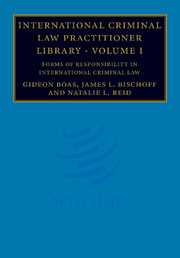Book contents
- Frontmatter
- Contents
- Foreword
- Table of authorities
- 1 Introduction
- 2 Joint criminal enterprise
- 3 Superior responsibility
- 4 Complicity and aiding and abetting
- 5 Planning, instigating and ordering
- 6 Concurrent convictions and sentencing
- 7 Conclusion
- Annex: Elements of forms of responsibility in international criminal law
- Index
4 - Complicity and aiding and abetting
Published online by Cambridge University Press: 08 January 2010
- Frontmatter
- Contents
- Foreword
- Table of authorities
- 1 Introduction
- 2 Joint criminal enterprise
- 3 Superior responsibility
- 4 Complicity and aiding and abetting
- 5 Planning, instigating and ordering
- 6 Concurrent convictions and sentencing
- 7 Conclusion
- Annex: Elements of forms of responsibility in international criminal law
- Index
Summary
The Statutes of the ICTY and ICTR include two provisions that have been interpreted, in the case law of those Tribunals, as reflecting what is termed ‘accessory liability’ in some domestic jurisdictions – that is, secondary participation in the commission of a crime. In such contexts, accessory liability is generally contrasted with ‘accomplice liability’, which covers any and all participation in the crime, including that of an individual who is as much (or more) an author of the crime as the physical perpetrator. In international criminal jurisprudence, however, the relationship between these two concepts has been complicated – and perhaps unnecessarily confused – by the terms used in the ad hoc Statutes, which include ‘aiding and abetting’ as a form of responsibility in Article 7(1) of the ICTY Statute and Article 6(1) of the ICTR Statute, and ‘complicity in genocide’ as a ‘punishable act’ in Article 4(3) of the ICTY Statute and Article 2(3) of the ICTR Statute.
This chapter reviews the practice of the ad hoc Tribunals with regard to the interpretation and application of these two sets of provisions, before moving to a comparative analysis of the manner in which other international and internationalised tribunals have approached the issues of aiding and abetting and complicity in genocide. The chapter discusses both aiding and abetting and complicity because the most sustained efforts to explain and clarify the scope and function of these provisions have come in the context of decisions and judgements examining the similarities and distinctions between the two concepts.
- Type
- Chapter
- Information
- International Criminal Law Practitioner Library , pp. 278 - 342Publisher: Cambridge University PressPrint publication year: 2008



